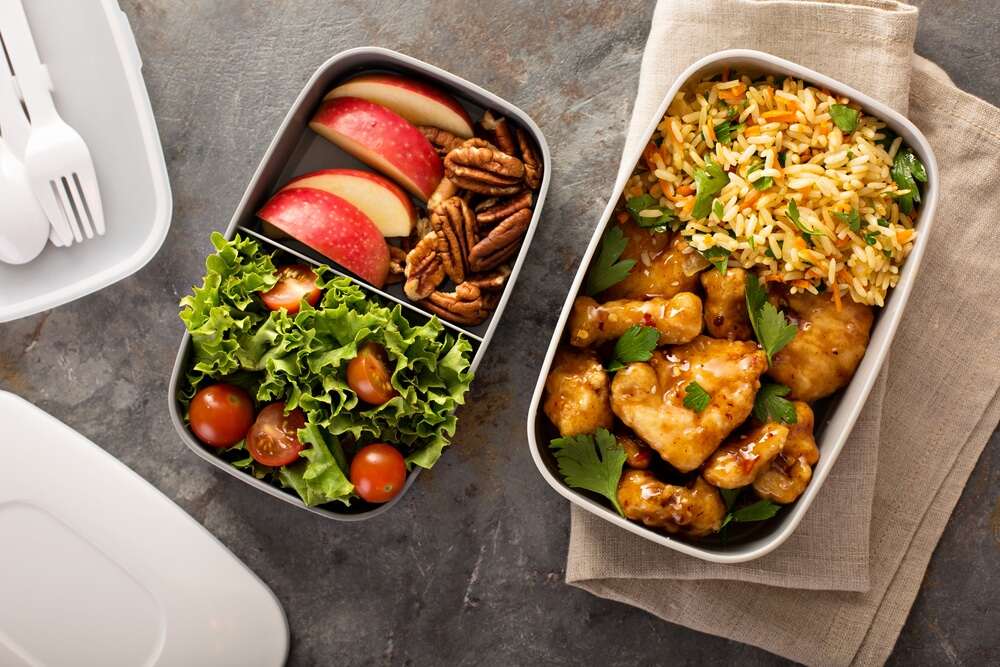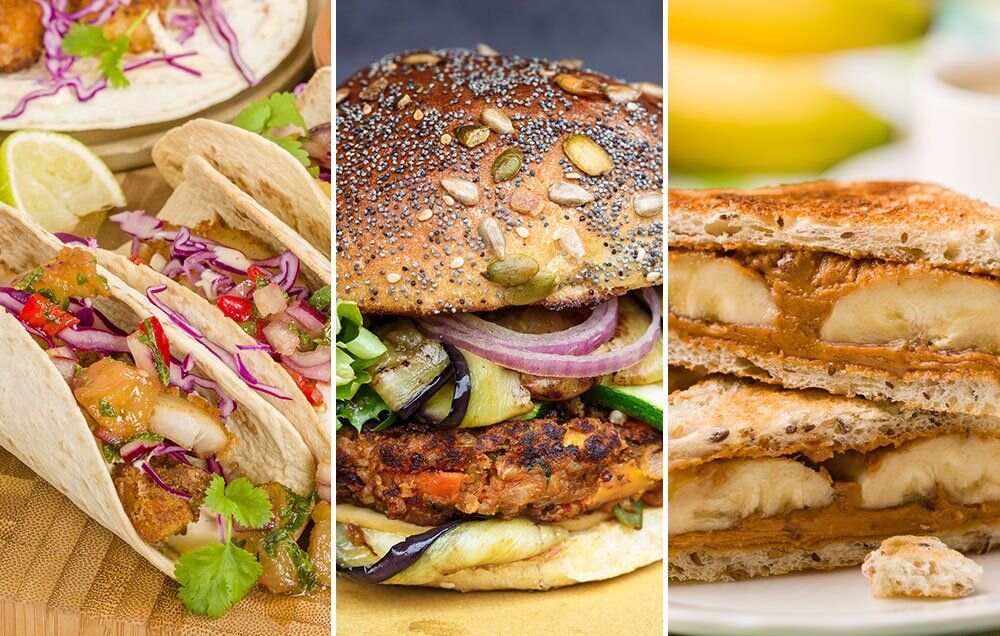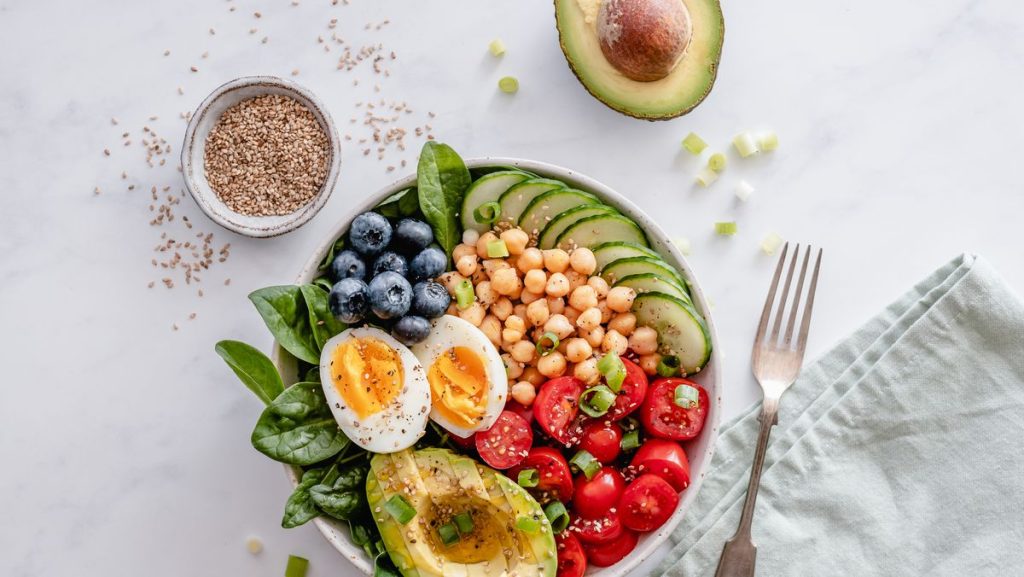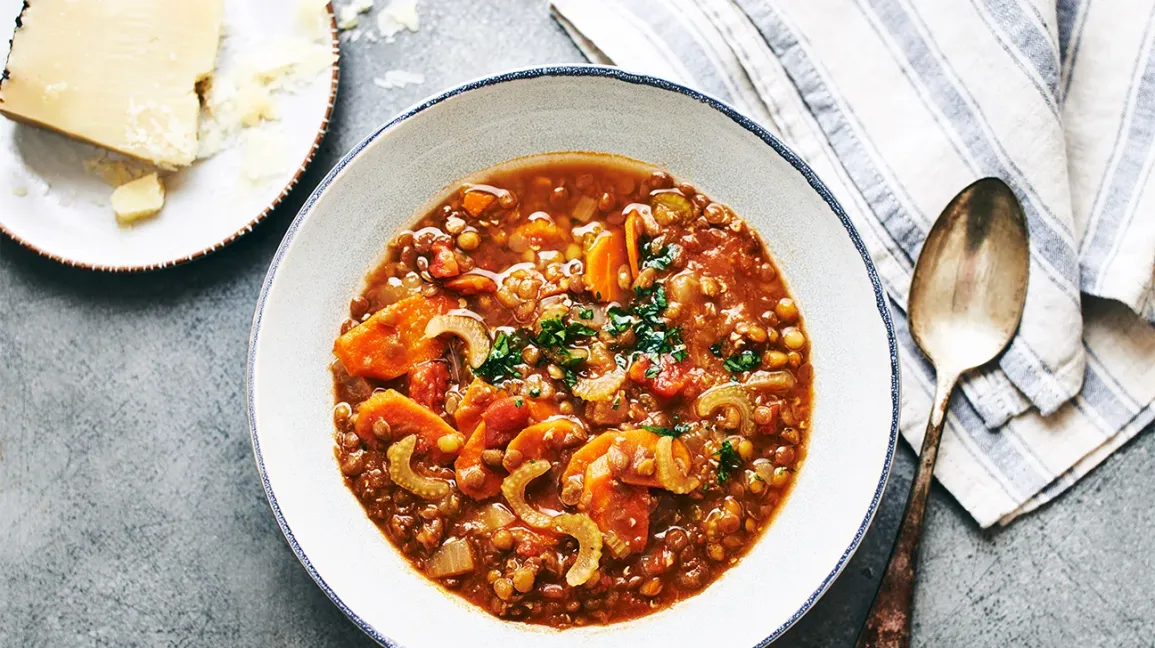Introduction:
Lunch For Losing Weight plays a critical role. It serves as the bridge between breakfast and dinner, providing essential nutrients and energy to sustain your body throughout the day. However, lunch can also be a pitfall if not approached mindfully, leading to overeating or poor food choices. Here’s how to make lunch your ally in the journey towards weight loss.

1.Portion Control: The Foundation of a Weight-Loss Lunch
Portion control is key to managing your calorie intake without feeling deprived. Instead of piling your plate high, aim for balanced portions. This not only helps in controlling calorie intake but also ensures that you’re getting a variety of nutrients.
2.Prioritize Protein
Protein is crucial for weight loss because it promotes satiety, helping you feel fuller for longer. This can prevent mid-afternoon snack cravings that often derail healthy eating plans. Incorporate lean protein sources such as grilled chicken, turkey, tofu, or legumes into your lunch. For a vegetarian option, consider a quinoa salad with chickpeas or lentils, which are both high in protein and fiber.
3.Include Healthy Fats
Healthy fats are important for a balanced diet and can aid in weight loss by enhancing satiety and reducing hunger. However, the key is moderation. Include sources of healthy fats like avocado, nuts, seeds, or olive oil in your lunch. A small handful of almonds or a drizzle of olive oil over your salad can add flavor and keep you satisfied.
4.Choose Fiber-Rich Foods
Fiber is another essential component of a weight-loss lunch. It aids in digestion, stabilizes blood sugar levels, and promotes a feeling of fullness. Vegetables, fruits, whole grains, and legumes are excellent sources of fiber. Incorporating a variety of these foods into your lunch not only supports weight loss but also contributes to overall digestive health.
5.Opt for Complex Carbohydrates
Not all carbs are created equal. Complex carbohydrates, such as those found in whole grains, vegetables, and legumes, are digested slowly, providing a steady release of energy. This helps to prevent the energy crashes that often lead to unhealthy snacking. Consider swapping white rice or bread for their whole-grain counterparts, like brown rice, quinoa, or whole wheat bread.
6.Hydration Matters
Staying hydrated is crucial for weight loss, yet it’s often overlooked. Drinking water before and during your meal can help control hunger and prevent overeating. Additionally, sometimes our bodies confuse thirst with hunger, leading to unnecessary snacking. Aim to drink a glass of water before you sit down for lunch to help manage your appetite.
7.Mindful Eating: Focus on Your Food
Mindful eating is a powerful tool for weight loss. It involves paying full attention to the experience of eating and enjoying your food without distractions. This practice helps you recognize your body’s hunger and fullness cues, preventing overeating. Take your time to savor each bite, chew slowly, and enjoy the flavors of your meal. Avoid eating in front of the TV or while working, as this can lead to mindless overeating.
8.Meal Prep for Success
Planning and preparing your lunches in advance is a great way to ensure you stick to your weight-loss goals. By preparing your meals ahead of time, you can control the ingredients and portions, avoiding the temptation of unhealthy options. Meal prepping can also save time and reduce stress during busy weekdays. Consider making a large batch of soup, salad, or grilled chicken at the beginning of the week, so you have healthy options ready to go.
9.Smart Substitutions
Making small changes to your lunch can have a big impact on your weight loss efforts. Opt for healthier alternatives such as swapping mayonnaise for Greek yogurt in your sandwiches, using lettuce wraps instead of bread, or choosing baked instead of fried options. These small substitutions can significantly reduce your calorie intake without sacrificing flavor.
10.Stay Consistent
Consistency is key when it comes to weight loss. While it’s okay to indulge occasionally, maintaining a balanced and nutritious lunch most days will help you achieve your weight loss goals. Remember that weight loss is a gradual process, and the most sustainable changes are those that you can maintain in the long term.
Sample Weight-Loss Lunch Ideas
Grilled Chicken Salad with Mixed Greens: Combine grilled chicken breast with a variety of leafy greens, cherry tomatoes, cucumber, and a light vinaigrette. Add a small portion of quinoa or brown rice for extra fiber and energy.
Vegetable Stir-Fry with Tofu: Stir-fry a colorful mix of vegetables like bell peppers, broccoli, and carrots with tofu in a light soy sauce. Serve over a small portion of brown rice or quinoa.
Turkey and Avocado Wrap: Use a whole-grain tortilla to wrap up lean turkey slices, avocado, spinach, and a smear of hummus. Pair with a side of baby carrots or a small fruit salad.
Lentil Soup with a Side Salad: Enjoy a hearty bowl of lentil soup packed with vegetables and herbs. Pair with a side salad dressed in olive oil and lemon juice for a fiber-rich, satisfying meal.
Conclusion
Lunch can be a powerful tool in your weight loss journey if approached with mindfulness and balance. By focusing on portion control, prioritizing protein, incorporating healthy fats and fiber, and making smart food choices, you can create satisfying meals that support your goals. Remember, the key to success is consistency and making sustainable changes that fit into your lifestyle. With a little planning and creativity, you can enjoy delicious, nutrient-dense lunches that keep you on track towards achieving your weight loss objectives.

Which lunch is best for weight loss?
When it comes to losing weight, what you eat for lunch can significantly impact your success. The best lunches for weight loss are those that are balanced, nutrient-dense, and satisfying enough to keep you full until your next meal. Let’s explore the key components of a weight-loss-friendly lunch and provide examples of meals that align with these principles.
1.Balance is Key: The Perfect Plate
A balanced lunch includes a mix of macronutrients—protein, healthy fats, and complex carbohydrates—alongside a generous portion of fiber-rich vegetables. This combination ensures that your meal provides sustained energy, keeps you satisfied, and supports your overall nutritional needs. Here’s how to structure a balanced lunch:
Protein (25-30% of your plate): Lean proteins like grilled chicken, turkey, tofu, or legumes are essential. They help maintain muscle mass and promote satiety, reducing the likelihood of afternoon cravings.
Healthy Fats (10-15% of your plate): Incorporate sources of healthy fats such as avocado, nuts, seeds, or olive oil. These fats enhance flavor, improve nutrient absorption, and keep you feeling full.
Complex Carbohydrates (25-30% of your plate): Choose whole grains like brown rice, quinoa, or whole wheat bread. Complex carbs provide a slow release of energy, preventing spikes in blood sugar and subsequent crashes.
Vegetables (40-50% of your plate): Load up on non-starchy vegetables like leafy greens, broccoli, bell peppers, and carrots. They are low in calories but high in fiber, vitamins, and minerals, making them ideal for weight loss.
2.Lean Protein-Packed Salads
Salads are often the go-to lunch for those looking to lose weight, but the key is to build a salad that is filling and nutrient-rich, not just a bowl of lettuce. A salad with lean protein, a variety of colorful vegetables, and a healthy fat source can be incredibly satisfying.
Example: A grilled chicken salad with mixed greens, cherry tomatoes, cucumbers, avocado, and a light vinaigrette dressing. Add some quinoa or chickpeas for an extra boost of protein and fiber.
3.Soup and Salad Combos
A hearty soup paired with a side salad is another excellent lunch option for weight loss. Soup, especially broth-based, can be low in calories yet filling due to its high water content. Pair it with a small salad to add more nutrients and fiber to your meal.
Example: A bowl of lentil soup with a side salad of mixed greens, carrots, and a sprinkle of sunflower seeds dressed in olive oil and lemon juice.
4.Wraps with Whole Grains and Lean Proteins
Wraps made with whole grain tortillas can be a great lunch option, especially when filled with lean proteins and plenty of vegetables. The key is to choose whole grains and avoid high-calorie condiments.
Example: A whole wheat wrap filled with turkey slices, avocado, spinach, and a smear of hummus. Serve with a side of sliced cucumbers and bell peppers for a crunchy, low-calorie addition.
5.Stir-Fried Vegetables with Protein
A vegetable stir-fry is a quick and easy lunch that can be customized to include your favorite vegetables and a lean protein source. Use a minimal amount of oil and opt for a light soy sauce or tamari to keep the calorie count in check.
Example: Stir-fried broccoli, bell peppers, carrots, and snap peas with tofu or chicken breast. Serve over a small portion of brown rice or quinoa.
6.Low-Calorie Sandwiches
Sandwiches can be part of a weight-loss lunch when made with the right ingredients. Choose whole grain bread, lean proteins, and plenty of vegetables, and go easy on high-calorie spreads.
Example: A sandwich made with whole grain bread, lean turkey, spinach, tomato, and mustard. Add a small side of fresh fruit or a handful of baby carrots for added fiber.
7.Vegetable and Protein Bowls
Bowl meals are versatile and allow you to combine a variety of ingredients in a single, satisfying dish. Start with a base of greens or whole grains, add a lean protein, and top with plenty of vegetables and a healthy fat source.
Example: A quinoa bowl with grilled salmon, roasted sweet potatoes, steamed broccoli, and a drizzle of tahini sauce.
Tips for Choosing the Best Lunch for Weight Loss
Avoid Empty Calories: Steer clear of refined carbs, sugary drinks, and high-calorie condiments. These add unnecessary calories without providing much nutritional value.
Watch Portions: Even healthy foods can contribute to weight gain if eaten in large quantities. Be mindful of portion sizes, especially with high-calorie ingredients like nuts, seeds, and dressings.
Stay Hydrated: Drinking water before and during your meal can help control your appetite and prevent overeating.
Plan Ahead: Meal prepping can help you avoid the temptation of unhealthy options and ensure you have nutritious, balanced meals ready to go.
Conclusion
The best lunch for weight loss is one that is balanced, nutrient-dense, and satisfying enough to keep you full until your next meal. By focusing on lean proteins, healthy fats, complex carbohydrates, and plenty of vegetables, you can create a lunch that supports your weight loss goals while still being enjoyable and filling. Remember, consistency is key, so aim to make these balanced lunches a regular part of your routine for long-term success.
Is lunch good for diet?
Lunch For Losing Weight In the world of dieting, lunch often finds itself under scrutiny. Some people skip it altogether in a bid to cut calories, while others view it as a necessary refueling point in their day. So, is lunch good for your diet? The answer is a resounding yes—if approached correctly. A well-balanced lunch is crucial for maintaining energy levels, managing hunger, and supporting overall health, all while contributing to your dietary goals. Let’s explore why lunch is essential for a successful diet.
1.Maintaining Energy Levels
Lunch is key to maintaining energy throughout the day. By the time midday rolls around, your breakfast is long digested, and your body needs a new source of fuel. Skipping lunch or opting for a nutritionally poor meal can lead to energy dips, making it harder to concentrate and perform daily tasks. This can also result in reaching for sugary snacks or caffeine later in the day, which can derail your diet.
A balanced lunch provides the necessary carbohydrates, proteins, and fats that your body needs to stay energized. Complex carbohydrates from whole grains, for example, offer a slow release of energy, while proteins and fats contribute to prolonged satiety, keeping your energy levels stable until your next meal.
2.Preventing Overeating Later in the Day
One of the biggest pitfalls of skipping lunch is the likelihood of overeating later in the day. When you don’t eat a proper lunch, your body may become overly hungry by the time dinner arrives, leading to larger portions and less mindful eating. This can result in consuming more calories than you would have if you had eaten a balanced lunch.
Moreover, the absence of a midday meal can trigger cravings for unhealthy, high-calorie snacks in the afternoon. These snacks are often high in sugar and unhealthy fats, which can quickly add up and sabotage your diet. A nutritious lunch helps prevent these cravings and keeps your hunger in check, making it easier to stick to your dietary goals.
3.Supporting Metabolism
Eating regular meals, including lunch, is important for keeping your metabolism active. When you skip meals, your body may enter a state of “conservation mode,” slowing down your metabolism to preserve energy. This can make it harder to lose weight or maintain a healthy weight.
A balanced lunch, particularly one that includes protein, can give your metabolism a boost. Protein requires more energy to digest than fats or carbohydrates, a process known as the thermic effect of food (TEF). Including a good source of protein in your lunch, such as lean meats, fish, tofu, or legumes, helps keep your metabolism running efficiently throughout the day.
4.Providing Essential Nutrients
Lunch is an opportunity to provide your body with essential nutrients that might be missing from other meals. A well-rounded lunch should include a variety of food groups, offering a mix of vitamins, minerals, fiber, and antioxidants. This diversity in your diet not only supports overall health but also helps you meet your daily nutrient requirements, which is crucial for any diet.
For instance, incorporating vegetables into your lunch ensures you’re getting fiber, vitamins A and C, and important minerals like potassium. Whole grains add complex carbohydrates and fiber, while lean proteins provide essential amino acids for muscle repair and maintenance. Healthy fats, such as those from avocados or olive oil, support brain health and hormone production.
5.Promoting Mindful Eating
Lunch offers a break in the day, a time to step away from work or other activities and focus on your meal. This is an excellent opportunity to practice mindful eating, which involves paying full attention to the experience of eating and savoring your food. Mindful eating has been shown to help people make healthier food choices, eat less, and feel more satisfied with their meals.
By sitting down for a planned lunch, you can better tune in to your body’s hunger and fullness cues, preventing overeating. This practice can also reduce stress and improve digestion, both of which are beneficial for weight management and overall health.
6.Contributing to Long-Term Dietary Success
Incorporating a balanced lunch into your daily routine is not just about immediate benefits; it’s also about setting up sustainable habits for long-term dietary success. Diets that involve skipping meals or severely restricting calories are often unsustainable and can lead to yo-yo dieting, where weight is lost and then regained.
A sustainable diet is one that you can maintain over the long term, and lunch plays a critical role in this. By making lunch a priority, you establish a routine that supports consistent energy levels, balanced nutrition, and healthy eating patterns, all of which contribute to lasting success in managing your weight and improving your health.
What Makes a Good Lunch for Diet?
To make lunch work for your diet, it should be balanced, nutrient-dense, and appropriate for your caloric needs. Here’s what a good lunch might include:
Lean Protein: Chicken, turkey, fish, tofu, or legumes help keep you full and support muscle maintenance.
Complex Carbohydrates: Whole grains like brown rice, quinoa, or whole wheat bread provide sustained energy.
Healthy Fats: Avocado, nuts, seeds, or olive oil add flavor and satiety.
Vegetables: A variety of colorful vegetables add fiber, vitamins, and minerals to your meal.
Portion Control: Be mindful of portion sizes to avoid overeating, especially with higher-calorie ingredients like nuts and oils.
Conclusion
Lunch is not just good for your diet—it’s essential. A balanced midday meal helps maintain energy levels, prevent overeating, support metabolism, and provide essential nutrients. By making lunch a mindful, nutritious part of your daily routine, you set yourself up for long-term dietary success and overall well-being. So, instead of skipping lunch or opting for less healthy options, take the time to prepare a meal that nourishes your body and aligns with your health goals. Start your day with healthy, egg-free breakfasts like smoothies, oatmeal, yogurt bowls, and avocado toast.

How can I lose weight naturally?
Losing weight naturally is not just about cutting calories or hitting the gym. It’s about adopting a balanced, holistic lifestyle that promotes overall well-being. By making gradual, sustainable changes to your daily habits, you can achieve weight loss that lasts. Here’s a comprehensive guide on how to lose weight naturally.
1.Prioritize Whole, Unprocessed Foods
One of the most effective ways to lose weight naturally is to focus on eating whole, unprocessed foods. These foods are rich in nutrients, lower in calories, and free from unhealthy additives found in many processed items.
Fruits and Vegetables: These are packed with fiber, vitamins, and minerals, and are low in calories. Aim to fill half your plate with a variety of colorful fruits and vegetables at every meal.
Whole Grains: Replace refined grains with whole grains like brown rice, quinoa, oats, and whole wheat. Whole grains provide more fiber and nutrients, keeping you fuller for longer.
Lean Proteins: Incorporate sources of lean protein like chicken, turkey, fish, tofu, and legumes into your meals. Protein is essential for muscle maintenance and helps control appetite.
Healthy Fats: Include healthy fats from sources like avocados, nuts, seeds, and olive oil. These fats are satisfying and support overall health.
2.Portion Control: Mind What You Eat
Even healthy foods can contribute to weight gain if eaten in large quantities. Practicing portion control helps you manage your calorie intake without feeling deprived.
Use Smaller Plates: This simple trick can help you eat less without feeling like you’re missing out.
Measure Portions: Especially when eating high-calorie foods like nuts, oils, or grains, measuring portions can help you avoid overeating.
Listen to Hunger Cues: Eat when you’re hungry, and stop when you’re satisfied, not stuffed. Paying attention to your body’s hunger signals is key to natural weight management.
3.Stay Hydrated
Water plays a crucial role in weight loss. Often, our bodies confuse thirst with hunger, leading to unnecessary snacking. Staying well-hydrated helps you manage hunger and supports your metabolism.
Drink Water Before Meals: Having a glass of water before eating can help reduce your appetite and prevent overeating.
Replace Sugary Drinks: Swap out sugary beverages like soda and juice with water, herbal teas, or sparkling water. This simple change can significantly reduce your calorie intake.
4.Get Moving: Incorporate Regular Physical Activity
Physical activity is an essential component of natural weight loss. Regular exercise helps you burn calories, build muscle, and improve overall health.
Find an Activity You Enjoy: Whether it’s walking, swimming, cycling, dancing, or yoga, find something you love so that it becomes a regular part of your routine.
Strength Training: Incorporating strength training exercises into your routine helps build muscle, which increases your resting metabolic rate, allowing you to burn more calories even when at rest.
Stay Active Throughout the Day: Simple changes like taking the stairs instead of the elevator, walking instead of driving for short distances, or standing more can add up to significant calorie burn over time.
5.Sleep Well
Sleep is often overlooked in weight loss, but it plays a crucial role. Poor sleep disrupts the hormones that regulate hunger, leading to increased appetite and cravings for unhealthy foods.
Aim for 7-9 Hours of Sleep: Ensure you’re getting enough sleep each night to support your body’s natural weight loss processes.
Create a Sleep Routine: Go to bed and wake up at the same time every day, create a relaxing bedtime routine, and make your sleeping environment comfortable and free from distractions.
6.Manage Stress
Chronic stress can lead to weight gain by triggering emotional eating and increasing the production of cortisol, a hormone linked to fat storage, particularly around the abdomen.
Practice Relaxation Techniques: Activities like deep breathing, meditation, yoga, or spending time in nature can help reduce stress.
Prioritize Self-Care: Make time for hobbies, social activities, and relaxation to maintain a balanced and low-stress lifestyle.
7.Eat Mindfully
Mindful eating involves paying attention to what and how you eat, which can help you enjoy your food more and prevent overeating.
Eat Slowly: Take the time to chew your food thoroughly and savor the flavors. Eating slowly allows your body to register when you’re full, preventing overeating.
Eliminate Distractions: Try to eat without distractions like watching TV or scrolling through your phone. Focus on your meal and the experience of eating.
Pay Attention to Hunger and Fullness Cues: Eat when you’re hungry, and stop when you’re satisfied. This helps you avoid eating out of boredom or habit.
8.Plan and Prepare Meals
Meal planning and preparation can be powerful tools in natural weight loss. By preparing meals at home, you have full control over the ingredients and portion sizes, making it easier to stick to your dietary goals.
Plan Your Meals for the Week: Create a menu that includes balanced meals and snacks. This helps you avoid last-minute unhealthy choices.
Prep Ingredients Ahead of Time: Wash, chop, and store ingredients in advance so that healthy meals are quick and easy to assemble.
Cook in Batches: Prepare large portions of healthy dishes that can be portioned out and stored for quick meals throughout the week.
9.Avoid Fad Diets
Fad diets promise quick results, but they are often unsustainable and can lead to nutrient deficiencies. Instead of following a restrictive diet, focus on making gradual, healthy changes that you can maintain over the long term.
Focus on Nutrient-Dense Foods: Prioritize foods that are rich in nutrients rather than simply low in calories.
Avoid Extreme Restrictions: Restricting entire food groups or drastically cutting calories can lead to nutritional imbalances and make it harder to stick to your diet.
Practice Moderation: Allow yourself to enjoy your favorite foods in moderation. Deprivation can lead to binge eating, so it’s better to enjoy treats occasionally in controlled portions.
10.Be Patient and Consistent
Natural weight loss is a gradual process, and it’s important to be patient and consistent with your efforts. Small, sustainable changes to your lifestyle can lead to lasting results over time.
Set Realistic Goals: Aim for a slow and steady weight loss of 1-2 pounds per week. This approach is more sustainable and less likely to lead to yo-yo dieting.
Track Your Progress: Keep a journal of your meals, physical activity, and how you feel. This can help you stay accountable and make adjustments as needed.
Celebrate Small Wins: Acknowledge and celebrate your progress, no matter how small. This helps keep you motivated and focused on your long-term goals. Indulge in a rich caramelized custard: Silky egg custard with a golden caramel top, baked to creamy perfection
Conclusion
Lunch For Losing Weight naturally involves making balanced, sustainable changes to your diet and lifestyle. By focusing on whole foods, practicing portion control, staying active, managing stress, and prioritizing sleep, you can achieve lasting weight loss without resorting to extreme measures. Remember, the key to natural weight loss is consistency and patience—small changes over time lead to significant, long-term results.

